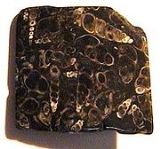
Elimia tenera
Encyclopedia
Elimia tenera, formerly known as Goniobasis tenera, is an extinct species
of freshwater snail
s with an operculum
, in the aquatic gastropod mollusk family Pleuroceridae
. This species flourished during the Eocene
and is now known only from the fossil
record.
The genus name Elimia was restored to this species in 1975; formerly it was placed in Goniobasis.
rich sedimentary rock from Wyoming
which hosts the fossil shells of Elimia tenera was originally incorrectly called Turritella agate. It was named after the sea snail genus Turritella
because of the resemblance of the freshwater snail shells to the Turritella fossils that are found in agate
in Texas
and California
. The Wyoming fossil shells, however, are in a freshwater sedimentary deposit and identifiable as the genus Elimia. These fossilized and less-silicified Elimia tenera occur in a region which is now southern Wyoming, northern Colorado and northeastern Utah.
Species
In biology, a species is one of the basic units of biological classification and a taxonomic rank. A species is often defined as a group of organisms capable of interbreeding and producing fertile offspring. While in many cases this definition is adequate, more precise or differing measures are...
of freshwater snail
Snail
Snail is a common name applied to most of the members of the molluscan class Gastropoda that have coiled shells in the adult stage. When the word is used in its most general sense, it includes sea snails, land snails and freshwater snails. The word snail without any qualifier is however more often...
s with an operculum
Operculum (gastropod)
The operculum, meaning little lid, is a corneous or calcareous anatomical structure which exists in many groups of sea snails and freshwater snails, and also in a few groups of land snails...
, in the aquatic gastropod mollusk family Pleuroceridae
Pleuroceridae
Pleuroceridae, common name pleurocerids, is a family of small to medium-sized freshwater snails, aquatic gilled gastropod mollusks in the superfamily Cerithioidea.These snails have an operculum and typically a robust high-spired shell....
. This species flourished during the Eocene
Eocene
The Eocene Epoch, lasting from about 56 to 34 million years ago , is a major division of the geologic timescale and the second epoch of the Paleogene Period in the Cenozoic Era. The Eocene spans the time from the end of the Palaeocene Epoch to the beginning of the Oligocene Epoch. The start of the...
and is now known only from the fossil
Fossil
Fossils are the preserved remains or traces of animals , plants, and other organisms from the remote past...
record.
The genus name Elimia was restored to this species in 1975; formerly it was placed in Goniobasis.
'Turritella' agate
The chalcedonyChalcedony
Chalcedony is a cryptocrystalline form of silica, composed of very fine intergrowths of the minerals quartz and moganite. These are both silica minerals, but they differ in that quartz has a trigonal crystal structure, while moganite is monoclinic...
rich sedimentary rock from Wyoming
Wyoming
Wyoming is a state in the mountain region of the Western United States. The western two thirds of the state is covered mostly with the mountain ranges and rangelands in the foothills of the Eastern Rocky Mountains, while the eastern third of the state is high elevation prairie known as the High...
which hosts the fossil shells of Elimia tenera was originally incorrectly called Turritella agate. It was named after the sea snail genus Turritella
Turritella
Turritella is a genus of medium-sized sea snails with an operculum, marine gastropod mollusks in the family Turritellidae. They have tightly coiled shells, whose overall shape is basically that of an elongated cone....
because of the resemblance of the freshwater snail shells to the Turritella fossils that are found in agate
Agate
Agate is a microcrystalline variety of silica, chiefly chalcedony, characterised by its fineness of grain and brightness of color. Although agates may be found in various kinds of rock, they are classically associated with volcanic rocks and can be common in certain metamorphic rocks.-Etymology...
in Texas
Texas
Texas is the second largest U.S. state by both area and population, and the largest state by area in the contiguous United States.The name, based on the Caddo word "Tejas" meaning "friends" or "allies", was applied by the Spanish to the Caddo themselves and to the region of their settlement in...
and California
California
California is a state located on the West Coast of the United States. It is by far the most populous U.S. state, and the third-largest by land area...
. The Wyoming fossil shells, however, are in a freshwater sedimentary deposit and identifiable as the genus Elimia. These fossilized and less-silicified Elimia tenera occur in a region which is now southern Wyoming, northern Colorado and northeastern Utah.
Paleoecology and paleogeology
The fossil beds are approximately 46 to 51 million years old and occur in the Laney Member of the Green River Formation. Evidence suggests that the Elimia tenera were deposited nearshore in a series of shallow lakes, which geologists have named the Fossil, Uinta and Gosiute Lakes. The climate was subtropical and there were intermittent volcanic eruptions. The best preserved Elimia tenera are from Lake Gosiute which fossils occur in the Fort Laclede Bed of the Laney Member at outcrops in Sweetwater County, in southwestern Wyoming.External links
- Allmon, Warren D. "Turritella Agate" Museum of the Earth

